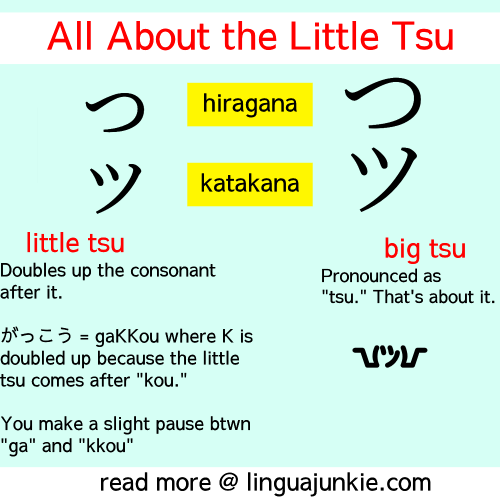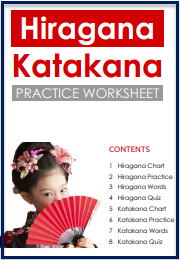How To Do Small Tsu On Keyboard
First of all, if you want to copy paste the pocket-sized tsu:
- っ ッ
But, if you're here for other reasons, no worries. This guide covers everything you need to know in 2-three minutes max.
- All About Information technology & Pronunciation
- Many Examples
- Katakana Version
- Romaji Version
- How to Type It

 | Want to acquire how to write in Japanese? Click here to Download your FREE Japanese Alphabet eBook by JapanesePod101. |
i. About the Minor Tsu Pronunciation
The small tsu (っ) in Japanese is chosen the chiisai tsu.
And it's smaller than the regular tsu. Here they are for comparing, Hiragana and Katakana;
- Small tsu in Hiragana: つっ
- Small tsu in Katakana: ツ ッ
If y'all're wondering about the pronunciation, well it has no sound of information technology'southward ain. Instead, it creates a double consonant audio. How?
Well, when y'all see it earlier a kana that starts with a consonant (hiragana or katakana), the small tsu doubles that consonant up. For example…
- Summer is "natsu" なつ
- Nuts is "nattsu" (discover the double T) ナッツ
So, when you double up the consonant and use the footling tsu, it almost sounds like there's a pause between "na" and "tsu," right?
Let's wait at these:
- 行って meaning "become!" (or can besides be "say" if y'all write it as 言って — both are the same pronunciation)
- いて meaning "be" (imperative course)
This double consonant pronunciation is likewise called a glottal terminate.
Of course, information technology's one thing to read about how the sounds…
…But it's a much better thing to HEAR how this little guy sounds.
So, let's movement on.
2. Pronunciation Examples
Here are some more examples of Japanese words with the trivial tsu.
Remember, as yous listen, look for that "suspension" in between the sounds. That's what the this fiddling character does and how it creates that "double" consonant sound.
Listen to these examples — printing the play button below.
1. School – Gakkou – がっこう
ii. Stamp – Kitte – きって
3. Buy (imperative/te-course) – Katte – 買って-
4. Laugh (imperative/te-class) – Waratte – 笑って
5. See (imperative/te-form) – Atte – 会って
6. Was adept (past tense adjective) – Yokatta – よかった
7. Wanted to eat (past tense -tai grade) – Tabetakatta – 食べたかった
3. Small Tsu in Katakana
Up above, you learned that the minor Katakana tsu is ッ and the normal tsu is ツ.
It kind of looks like a smiley face, huh?
So why bring up this in the context of Katakana?
If you always were wondering, "what'south my proper name in Japanese…"
Well, since many foreign words make their mode into Japanese — including your name, if you were to interpret yourself to Japanese – there'll be quite a chip of tsu's involved.
See, the Japanese alphabet mainly follows a consonant + vowel design, or just vowels alone ("n" is an outlier.) So, if y'all're bringing in an odd mix of consonants from another language, or if a discussion (or your name) ends with a consonant, and then information technology volition have on this "double consonant" that'due south created by the little tsu.
What exercise I mean?
Take a look at a name similar: Ted. The "te" is a consonant + vowel pair, only "d" is alone. So, the "d" has to accept on a vowel when making it sound Japanese.
Ted becomes Teddo. And because the D in Ted sounds quite strong, "tedo" (one d) is not enough (and sounds weird in Japanese.)
- Ted — Teddo — テッド
Accept another name like Alex. A becomes it's ain charater, Le becomes "Re" and 10 is a sole consonant. So, in that example, you add together a "su" and it becomes "Arekkusu" considering "Arekku" would exist more for someone named "Alec."
- Alex – Arekkusu – アレックス
By the way if you're wondeirng why we went with "o" in "Teddo" but "u" in "Arrekkusu," it just sounds more natural in Japanese. Arekkuso would be more similar "Alexo" is someone was named similar that.
Here are some other examples
- Brittany – Burittanii – ブリッタニー
- Eric – Erikku – エリック
- Jack – Jakku – ジャック
- Max – Makkusu – マックス
- Rebecca – Rebekka -レベッカ
- Zack – Zakku – ザック
Once more, for the most function — merely names that finish in a consonant other than N or 50… or names with existing double consonants (Rebecca) will become a little tsu.
So, what about you and your proper noun? Would information technology have a teeny tiny tsu in it? Get out a annotate.
4. Romaji Small Tsu
Nosotros've covered the little tsu in Hiragana… (っ)
In Katakana… (ッ)
Now what about the Romaji version?
Well, if yous were paying attention to the all the foreign word/name talk to a higher place, y'all'll already know that there'southward no romaji minor tsu.
Romaji is a phonetic version of the Japanese kana (hiragana/katakana/etc.) Significant, information technology'south written based on how it sounds.
And what does it sound like? Like a double consonant.
And so, when you take a little tsu in Hiragana or Katakana and desire to write the romaji version, just double up the consonants.
Examples:
- よかった
- Encounter the little tsu earlier the "た/Ta?" Double up the "T."
- Result: yokatta
- がっこう
- See the little tsu earlier the "こう/kou?" Double up the "K."
- Consequence: gakkou
- テッド
- See the small-scale katakana tsu before the "ド/do?" Double upwards the "D."
- Result: teddo
And that'south how you practice it in romaji.
5. How to type the small tsu?
Cracking question.
I'll presume you already have a Japanese keyboard on your calculator, iPhone or Android.
Somewhere in your settings, there's an choice for keyboards/languages where you lot can add boosted languages. On the iPhones, it's Settings > Keyboards > Add New Keyboard. I personally use the Japanese romaji keyboard which lets me type in English language characters which become converted to Hiragana/Katakana on screen:

And here's how it is in action.
The fashion I type the minor tsu — if you've been paying attention — is by typing the consonant twice. Whether information technology's "d d" in Teddo or "d d" in Reddo. Spotter below.
Conclusion
Now you know a skilful deal about the little tsu.
And you lot probably realize it's no big deal.
Possibly you were a beginner and were confused about information technology — which is cool. We've been there.
Anyways. hope this was useful.
– The Chief LinguaJunkie
 | Want to learn how to write in Japanese? Click here to Download your FREE Japanese Alphabet eBook past JapanesePod101. |
Source: https://www.linguajunkie.com/japanese/small-tsu-pronunciation

0 Response to "How To Do Small Tsu On Keyboard"
Post a Comment